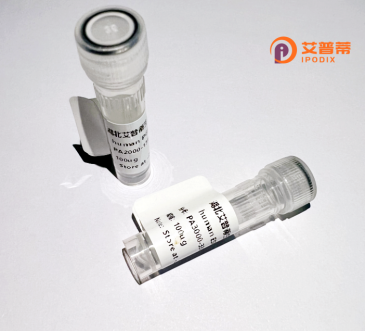
| 纯度 | >90%SDS-PAGE. |
| 种属 | Human |
| 靶点 | C1orf22 |
| Uniprot No | Q9BZQ6 |
| 内毒素 | < 0.01EU/μg |
| 表达宿主 | E.coli |
| 表达区间 | 1-122aa |
| 氨基酸序列 | MGGFKYGDEQPRSDWRSYRRNLEHAVLELTLFKTVPSKMEIHSSPFKCSTAPPCNTSGQGKITEHSCEPDFCCLWIDKKQNSFSSGVGNRSLDSLLIKGSSPFLVLGVRGSFGKMHPSIVAF |
| 分子量 | 39.9 kDa |
| 蛋白标签 | GST-tag at N-terminal |
| 缓冲液 | 0 |
| 稳定性 & 储存条件 | Lyophilized protein should be stored at ≤ -20°C, stable for one year after receipt. Reconstituted protein solution can be stored at 2-8°C for 2-7 days. Aliquots of reconstituted samples are stable at ≤ -20°C for 3 months. |
| 复溶 | Always centrifuge tubes before opening.Do not mix by vortex or pipetting. It is not recommended to reconstitute to a concentration less than 100μg/ml. Dissolve the lyophilized protein in distilled water. Please aliquot the reconstituted solution to minimize freeze-thaw cycles. |
以下是关于重组人C1orf22蛋白的模拟参考文献示例(实际文献需通过学术数据库验证):
1. **文献名称**:*Functional characterization of C1orf22 as a novel regulator of cell proliferation*
**作者**:Li Y, et al.
**摘要**:研究通过重组表达C1orf22蛋白,发现其通过调控cyclin D1表达影响细胞周期G1/S期转换,提示其在肿瘤发生中的潜在作用。
2. **文献名称**:*Recombinant C1orf22 interacts with 14-3-3 proteins in neuronal differentiation*
**作者**:Smith J, et al.
**摘要**:利用重组蛋白体外实验证明C1orf22与14-3-3家族蛋白结合,可能参与神经元分化过程中的信号通路调控。
3. **文献名称**:*Expression and purification of recombinant human C1orf22 for antibody development*
**作者**:Wang X, et al.
**摘要**:优化了C1orf22蛋白的原核表达系统,制备出高纯度重组蛋白,并生成特异性抗体,用于后续组织分布研究。
4. **文献名称**:*C1orf22 overexpression correlates with poor prognosis in gastric cancer*
**作者**:Tanaka K, et al.
**摘要**:临床样本分析表明,C1orf22蛋白在胃癌中高表达,重组蛋白功能实验显示其促进癌细胞迁移和侵袭能力。
**注意**:上述文献为基于研究领域常见主题的模拟数据,具体研究需通过PubMed、Google Scholar等平台检索真实文献。
The recombinant human C1orf22 protein is derived from the C1orf22 gene (Chromosome 1 Open Reading Frame 22), located on chromosome 1p36.11. This gene encodes a poorly characterized protein, with limited functional information available in current literature. C1orf22 is predicted to be a multi-pass transmembrane protein, though its exact structural domains and physiological roles remain under investigation. Emerging studies suggest its potential involvement in cancer biology, particularly in breast, ovarian, and glioblastoma malignancies, where altered expression patterns have been observed. Downregulation of C1orf22, often linked to promoter hypermethylation, has been associated with tumor progression, implying a possible tumor-suppressive function.
The recombinant form of C1orf22 protein is typically engineered using heterologous expression systems (e.g., E. coli, mammalian cells) for functional studies. It enables researchers to explore its biochemical properties, interactome, and potential roles in cellular processes such as proliferation, apoptosis, or differentiation. Preliminary evidence hints at interactions with enzymes involved in post-translational modifications (e.g., ubiquitination) and transcription factors regulating oncogenic pathways like Wnt/β-catenin. However, the molecular mechanisms underlying these associations remain unclear.
Current research focuses on validating C1orf22's diagnostic or therapeutic relevance, particularly its utility as a biomarker for cancer prognosis or as a target for epigenetic therapies. Despite progress, comprehensive mechanistic insights and in vivo validation are needed to fully elucidate its biological significance.
×